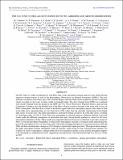| dc.contributor.author | Person, Michael J. | |
| dc.contributor.author | Bosh, Amanda S. | |
| dc.contributor.author | Levine, Stephen E. | |
| dc.contributor.author | Gulbis, Amanda A. S. | |
| dc.contributor.author | Zangari, A. M. | |
| dc.contributor.author | Zuluaga, Carlos Andres | |
| dc.contributor.author | Sallum, S. | |
| dc.contributor.author | Springmann, A. | |
| dc.date.accessioned | 2015-01-16T16:01:51Z | |
| dc.date.available | 2015-01-16T16:01:51Z | |
| dc.date.issued | 2013-08 | |
| dc.date.submitted | 2013-01 | |
| dc.identifier.issn | 0004-6256 | |
| dc.identifier.issn | 1538-3881 | |
| dc.identifier.uri | http://hdl.handle.net/1721.1/92934 | |
| dc.description.abstract | On 2011 June 23, stellar occultations by both Pluto (this work) and Charon (future analysis) were observed from numerous ground stations as well as the Stratospheric Observatory for Infrared Astronomy (SOFIA). This first airborne occultation observation since 1995 with the Kuiper Airborne Observatory resulted in the best occultation chords recorded for the event, in three visible wavelength bands. The data obtained from SOFIA are combined with chords obtained from the ground at the IRTF, the U.S. Naval Observatory Flagstaff Station, and Leeward Community College to give the detailed state of the Pluto-Charon system at the time of the event with a focus on Pluto's atmosphere. The data show a return to the distinct upper and lower atmospheric regions with a knee or kink in the light curve separating them as was observed in 1988, rather than the smoothly transitioning bowl-shaped light curves of recent years. The upper atmosphere is analyzed by fitting a model to all of the light curves, resulting in a half-light radius of 1288 ± 1 km. The lower atmosphere is analyzed using two different methods to provide results under the differing assumptions of particulate haze and a strong thermal gradient as causes for the lower atmospheric diminution of flux. These results are compared with those from past occultations to provide a picture of Pluto's evolving atmosphere. Regardless of which lower atmospheric structure is assumed, results indicate that this part of the atmosphere evolves on short timescales with results changing the light curve structures between 1988 and 2006, and then reverting these changes in 2011 though at significantly higher pressures. Throughout these changes, the upper atmosphere remains remarkably stable in structure, again except for the overall pressure changes. No evidence of onset of atmospheric collapse predicted by frost migration models is seen, and the atmosphere appears to be remaining at a stable pressure level, suggesting it should persist at this full level through New Horizon's flyby in 2015. | en_US |
| dc.description.sponsorship | United States. National Aeronautics and Space Administration (Planetary Astronomy Grant NNX10AB27G) | en_US |
| dc.description.sponsorship | National Research Foundation (South Africa) | en_US |
| dc.language.iso | en_US | |
| dc.publisher | IOP Publishing | en_US |
| dc.relation.isversionof | http://dx.doi.org/10.1088/0004-6256/146/4/83 | en_US |
| dc.rights | Article is made available in accordance with the publisher's policy and may be subject to US copyright law. Please refer to the publisher's site for terms of use. | en_US |
| dc.source | American Astronomical Society | en_US |
| dc.title | THE 2011 JUNE 23 STELLAR OCCULTATION BY PLUTO: AIRBORNE AND GROUND OBSERVATIONS | en_US |
| dc.type | Article | en_US |
| dc.identifier.citation | Person, M. J., E. W. Dunham, A. S. Bosh, S. E. Levine, A. A. S. Gulbis, A. M. Zangari, C. A. Zuluaga, et al. “THE 2011 JUNE 23 STELLAR OCCULTATION BY PLUTO: AIRBORNE AND GROUND OBSERVATIONS.” The Astronomical Journal 146, no. 4 (August 29, 2013): 83. © 2013 The American Astronomical Society | en_US |
| dc.contributor.department | Massachusetts Institute of Technology. Department of Earth, Atmospheric, and Planetary Sciences | en_US |
| dc.contributor.mitauthor | Person, Michael J. | en_US |
| dc.contributor.mitauthor | Bosh, Amanda S. | en_US |
| dc.contributor.mitauthor | Levine, Stephen E. | en_US |
| dc.contributor.mitauthor | Gulbis, Amanda A. S. | en_US |
| dc.contributor.mitauthor | Zangari, A. M. | en_US |
| dc.contributor.mitauthor | Zuluaga, Carlos Andres | en_US |
| dc.contributor.mitauthor | Sallum, S. | en_US |
| dc.contributor.mitauthor | Springmann, A. | en_US |
| dc.relation.journal | The Astronomical Journal | en_US |
| dc.eprint.version | Final published version | en_US |
| dc.type.uri | http://purl.org/eprint/type/JournalArticle | en_US |
| eprint.status | http://purl.org/eprint/status/PeerReviewed | en_US |
| dspace.orderedauthors | Person, M. J.; Dunham, E. W.; Bosh, A. S.; Levine, S. E.; Gulbis, A. A. S.; Zangari, A. M.; Zuluaga, C. A.; Pasachoff, J. M.; Babcock, B. A.; Pandey, S.; Amrhein, D.; Sallum, S.; Tholen, D. J.; Collins, P.; Bida, T.; Taylor, B.; Bright, L.; Wolf, J.; Meyer, A.; Pfueller, E.; Wiedemann, M.; Roeser, H.-P.; Lucas, R.; Kakkala, M.; Ciotti, J.; Plunkett, S.; Hiraoka, N.; Best, W.; Pilger, E. J.; Micheli, M.; Springmann, A.; Hicks, M.; Thackeray, B.; Emery, J. P.; Tilleman, T.; Harris, H.; Sheppard, S.; Rapoport, S.; Ritchie, I.; Pearson, M.; Mattingly, A.; Brimacombe, J.; Gault, D.; Jones, R.; Nolthenius, R.; Broughton, J.; Barry, T. | en_US |
| dc.identifier.orcid | https://orcid.org/0000-0002-9468-7477 | |
| dc.identifier.orcid | https://orcid.org/0000-0003-4772-528X | |
| dc.identifier.orcid | https://orcid.org/0000-0003-1327-1398 | |
| mit.license | PUBLISHER_POLICY | en_US |
| mit.metadata.status | Complete | |
